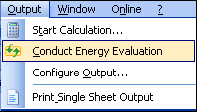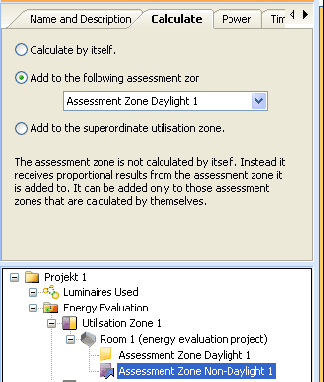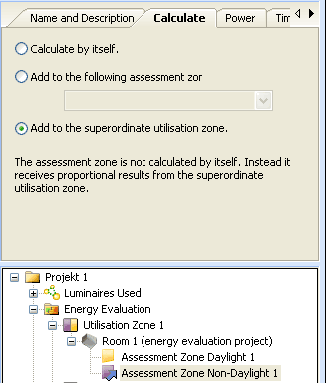- Главная
-
Учебник
- DIALux 4
- DIALux evo
- IES
- Форум
- Галерея
- Блоги
-
Скачать
- DIALux
- Базы
- Плагины
- 3D модели
- Текстуры
- Книги
-
Новости
Calculation and results
11 сентября 2012 - АдминWhen the complete building is subdivided into utilization zones, all energy evaluation rooms are created, all assessment zones are determined and all parameters are adjusted, then it’s time to calculate the energy demands and other energetic characteristics. That’s the moment, when the real energy evaluation is done.

Fig. 431 Start of an energy evaluation in menu „Output“
You can start the energy evaluation either with “Conduct energy evaluation” in menu “Output” or with the icon of the same name.

Fig. 432 Start of an energy evaluation with the icon of the same name (second from left)
In both cases a complete energy evaluation for the whole energy evaluation project is done. There’s no selection of utilisation zones, energy evaluation rooms or assessment zones, as known from light planning calculations. That is because energy evaluation is very quick. It needs a lot less time than the user reading and editing a selection dialogue.
As mentioned before, the real energy evaluation is done at the level of assessment zones. So when an evaluation is started, the energy demand for each assessment zone is calculated. Depending on the selected standard this may be “only” the total energy used for lighting or additionally the energy consumption used for illumination and the luminaire parasitic energy consumption. In each case annual consumption values are calculated. And that’s it, almost.
All other characteristics can be derived from these values. Monthly values can be obtained with the help of redistribution factors; values for energy evaluation rooms are nothing else than sums of values of their contained assessment zones, values for utilization zones nothing else than sums of values of their contained energy evaluation rooms, and so on. Even the Lighting Energy Numeric Indicator (LENI) from EN 15193 is nothing else than an area weighted value.
For assessment zones that are add to another assessment zone or to the super ordinate utilization zone, things are different. Such zones are not calculated independently.

Fig. 433 An assessment zone that is added to another assessment zone

Fig. 434 An assessment zone, that is added to the super ordinate utilisation zone
When an assessment zone is added to another zone or to the super ordinate utilization zone, then this zone is no longer calculated independently, that is on the basis of its parameters. Instead, the results of the other assessment zone respectively the results of the super ordinate utilization zone are allocated to the dependent assessment zone.
Such dependent assessment zones get their results, as soon as the independent assessment zones are calculated. Results are simply allocated area weighted.
There are two main constraints concerning adding of assessment zones to others: First, you can only add to such assessment zones that are independently calculated. Second, each utilization zone needs at least one assessment zone that is independently calculated.Рейтинг: 0 Голосов: 0 4127 просмотровКомментарии (0)Manual
